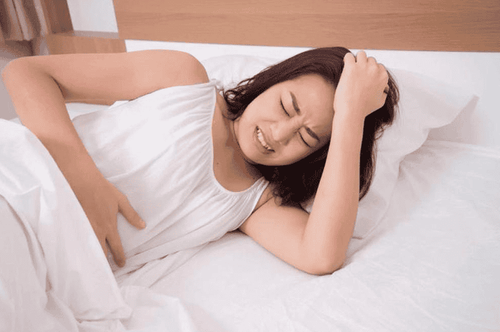This is an automatically translated article.
The article was professionally consulted with Specialist Doctor II Tran Thi Mai Huong - Obstetrician and Gynecologist - Department of Obstetrics and Gynecology - Vinmec Hai Phong International General Hospital.Dysmenorrhea is a very common abdominal pain in many women when it is time to menstruate. However, a pain that is too severe or has additional worrisome signs is a matter of concern. Understanding dysmenorrhea helps you to overcome this pain gently as well as detect potential gynecological problems early.
1. What is dysmenorrhea?
The menstrual cycle is a normal physiological phenomenon in women. Accordingly, when the egg is ovulated and not fertilized, the uterine lining is shed and expelled, and menstrual bleeding occurs. Under the control of female sex hormones, this process affects many organs such as the uterus, ovaries, vagina, breasts and visceral nervous system.Therefore, when it is time to menstruate, a woman feels a pain appearing from the lower abdomen, which can spread to the chest, breast enlargement, making it difficult to breathe or spreading to the thighs and private area. Sometimes the pain spreads throughout the abdomen, sometimes accompanied by digestive disorders, back pain, headache, low-grade fever, weakness in limbs, emotional changes,... This set of unpleasant sensations is called menstrual system.
Trắc nghiệm: Sự hiểu biết của bạn về kinh nguyệt
Kinh nguyệt có vai trò quan trọng đối với sức khỏe sinh sản, do đó nữ giới cần chủ động trang bị kiến thức để theo dõi và kiểm soát tình trạng sức khỏe. Bài trắc nghiệm sau đây sẽ giúp bạn hiểu hơn về chu kỳ kinh nguyệt của bản thân.2. Classification of the nervous system
Dysmenorrhea is divided into two types: primary dysmenorrhea and secondary dysmenorrhea.
2.1. Primary dysmenorrhea
Primary dysmenorrhea, also known as idiopathic dysmenorrhea.
This is menstrual cramps of an ovulatory menstrual cycle but examination does not find a physical cause.
Abdominal pain in idiopathic dysmenorrhea is described as a feeling of stabbing pain in the lower abdomen or sharp, intermittent, cramping pain, pain radiating to the back or inner thighs. Pain usually occurs several hours before menstruation or immediately begins, lasts a few days and may be accompanied by nausea, fainting, diarrhea, headache, and fever.
The cause of primary dysmenorrhea is thought to be due to the muscular layers of the uterine wall contracting to expel blood from the uterine cavity. When the contraction is excessive, the muscles are deprived of oxygen and nutrients, the products of anaerobic metabolism causing pain. However, many theories agree that neurotoxins are released when the body is under extreme stress because of menstrual blood without being equipped with the necessary knowledge. Some other subjects are said to be affected when they observe menstrual cramps from the women around.
Most women experience idiopathic dysmenorrhea at least once during their reproductive years. This type of dysmenorrhea often appears early when the body marks the milestone of puberty. The first period occurs immediately after the first menstrual cycles in life. Accordingly, the age group experiencing this syndrome is the highest from puberty until the age of 30. Even so, there are still many women who often have menstrual cramps that repeat each cycle until menopause.

2.2. Secondary dysmenorrhea
Secondary dysmenorrhea is dysmenorrhea when a cause or pathology is found to cause this condition.
Symptoms of dysmenorrhea in secondary dysmenorrhea can be similar to those of primary dysmenorrhea, but the pain usually appears about a week before menstruation. Sometimes, the pain lasts longer until the period stops or the pain comes on suddenly at other times of the month.
The onset of secondary dysmenorrhea is usually later than primary dysmenorrhea. At this point, most women have gone through many menstrual cycles, after many years with no or little dysmenorrhea. Therefore, the most common age for secondary dysmenorrhea is between 30 and 40 years old.
Common physical diseases causing secondary dysmenorrhea are endometriosis, metritis, uterine fibroids, uterine polyps, uterine cancer, IUD insertion, uterine stenosis, endometrial adhesions, uterine malformations, ovarian cysts or even an IUD. Accordingly, the pain mechanism in secondary dysmenorrhea depends on different pathologies.
To diagnose the cause of secondary dysmenorrhea, the patient needs to be examined by a gynecologist. The doctor will perform a clinical examination and sometimes will need to order additional imaging tests to confirm the diagnosis and guide treatment.
3. Is dysmenorrhea dangerous?
Primary (idiopathic) dysmenorrhea is an unpleasant phenomenon that repeats every cycle. In most women, when their period stops, its symptoms will go away on their own without needing any treatment. After many cycles, they will learn to "adapt" to those discomforts. However, in a few, especially those with overly sensitive physical conditions, dysmenorrhea affects their ability to work, study and daily activities. However, they silently endure this pain without going to the doctor or taking pain relievers. In the long term, dysmenorrhea has a negative impact on the psychology and health of the patient, making menstrual days become "torture".
For secondary dysmenorrhea, this can be seen as an alarm symptom for underlying gynecological conditions. If the pain lasts longer than the menstrual days or occurs after many years of the cycle, does not respond to analgesics, accompanied by abnormalities of the menstrual nature such as polymenorrhea, amenorrhea, menorrhagia, hypermenorrhea ..., the patient should not be subjective. It is necessary to seek early medical examination and treatment before the disease progresses seriously, adversely affecting reproductive function, causing infertility, miscarriage, consecutive premature birth,...
4. Is dysmenorrhea treatable?
Idiopathic dysmenorrhea is completely approved if you have prepared knowledge and psychology carefully. For girls who have just had their first period, they need to be cared for and explained by an experienced adult in detail about menstrual physiology and hygiene. From that, it should be known that menstruation is not a disease but just a normal phenomenon of women.
Non-drug measures to limit dysmenorrhea are warm compressing the lower abdomen, massage, relaxation, drinking enough water, increasing foods rich in magnesium, zinc, omega-3 fatty acids, B vitamins, vitamin E. In addition, regular exercise and sports, an active and active lifestyle have also been proven effective in preventing menstrual cramps when the cycle days are coming. Absolutely do not use alcohol, smoke or be exposed to smoke, addictive substances, stimulants, ... because it will make the pain last longer.
Particularly in cases of secondary dysmenorrhea, in order to resolve pain symptoms, it is necessary to thoroughly treat the physical disease. At that time, the patient needs to see a specialist soon to make an appropriate treatment plan.
Please dial HOTLINE for more information or register for an appointment HERE. Download MyVinmec app to make appointments faster and to manage your bookings easily.














